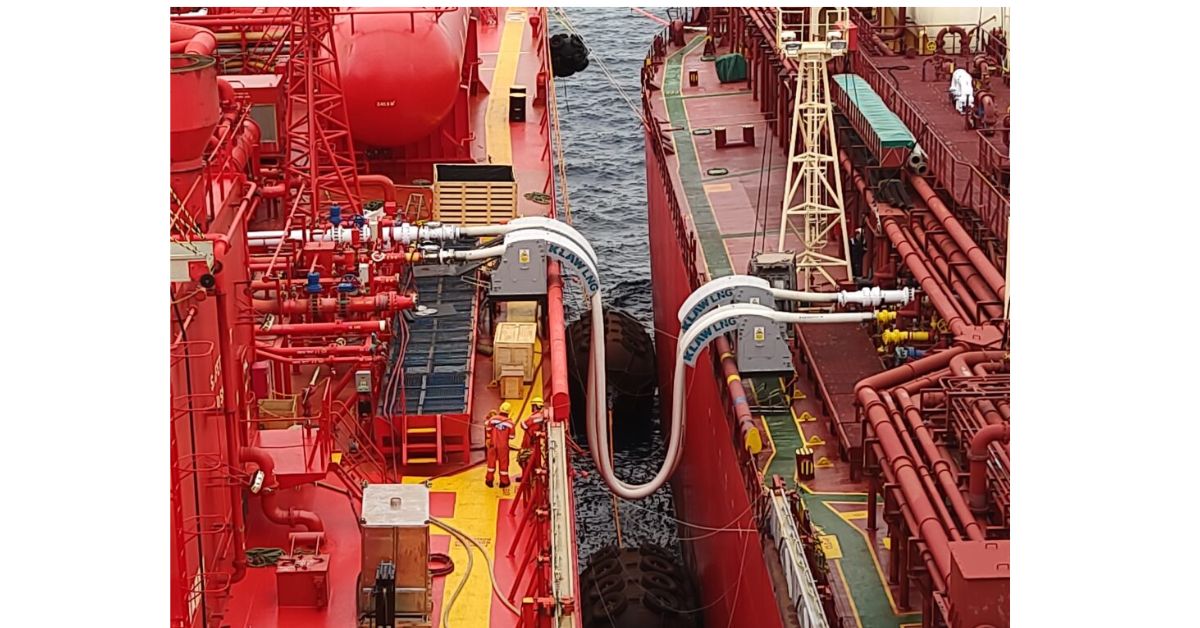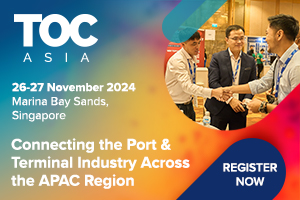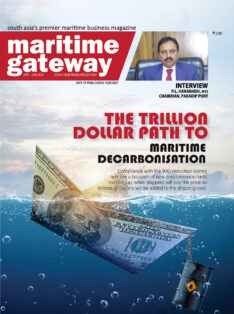- Transfers reinforce Pilbara’s potential to be a green ammonia bunkering hub.
- Ammonia transfers were conducted under strict safety protocols, with requisite approvals, and overseen by Pilbara Ports and Australian Government agencies.
- The Pilbara is home to the world’s largest bulk export port, exporting iron ore, salt, lithium, natural gas, ammonia and other commodities.
- The Pilbara is a highly prospective region for low to zero greenhouse gas emissions shipping, and Port Dampier has extensive experience with ammonia export given Yara’s nearby operations that account for 5% of the world’s tradable ammonia and its record of shipping 11.8 million tonnes incident-free to date.
Singapore / Australia: 16 September 2024 – A Global Centre for Maritime Decarbonisation-led consortium has successfully conducted ship-to-ship transfers of ammonia at anchorages within the Port of Dampier on 14 September 2024.
Two transfers took place between the Green Pioneer (owner MOL), a 35,000 cubic metres (cbm) ammonia carrier, and the Navigator Global (owner Navigator Gas), a 22,500 cbm ammonia carrier. Yara Clean Ammonia (YCA) provided the ammonia used in the transfers.
The first transfer involved 4,000 cbm (approximately 2,700 tonnes) of ammonia from the Green Pioneer to the Navigator Global at the Port of Dampier. The same ammonia cargo was then transferred back from the Navigator Global to the Green Pioneer.
Each transfer operation took approximately six hours, with the first transfer completed at 0830 hours on 14 September.
Successful transfers boost ammonia bunkering potential in Pilbara
A tripartite collaboration between the Global Centre for Maritime Decarbonisation (GCMD), Pilbara Ports and YCA was formed to realise Pilbara’s potential as a low- greenhouse gas (GHG) emission ammonia bunkering hub. This region was previously
highlighted by a Global Maritime Forum study as a viable location for ammonia bunkering. Construction to enable renewable ammonia production by 2025 has commenced at Yara Pilbara’s facility.
The successful transfers demonstrate the operational viability of future ammonia bunkering in the Pilbara region of Western Australia.
This pilot also marks a step towards operationalising a low-GHG emission shipping route for international iron ore trade, which is projected to require 1 to 1.5 million tonnes of ammonia by 2035, according to a joint 2023 study undertaken by Pilbara Ports, Yara Clean Ammonia and Lloyd’s Register.
Ship-to-ship transfer as a proxy to ammonia bunkering
In the absence of ammonia bunkering vessels and ammonia-fuelled ships at this stage, ship-to-ship transfers at anchorage offer the closest proxy to bunkering operations when it replicates the essential steps involved.
With this objective in mind, the trial began with a transfer at the Port of Dampier as a proxy to breakbulk, leveraging the port’s experience with ammonia export. The second transfer demonstrated the potential of bunkering operations, extendable also to other ports nearby, where such future operations for bulk carriers are expected to take place.
To operationalise this pair of transfers, the consortium built on proven procedures and incorporated additional safety mitigation measures.
These measures include the use of emergency release couplings, emergency shutdown devices and other safety equipment, and the implementation of hot-gas and nitrogen purging procedures after ammonia transfer. These were developed in close collaboration with safety consultants, ship-to-ship transfer service providers, ports, Australian Government agencies and experienced operators of ammonia vessels and a producer.
To mimic future ammonia bunkering scenarios, the Pilbara trials deployed a handysize and a midsize gas carrier with capacities that are similar to that expected of ammonia bunker vessels.
Safety studies and emergency response procedures developed for the transfers
Based on the findings and recommendations from GCMD’s 2023 safety study on piloting ammonia bunkering and its plans for actual operations, Pilbara Ports, Yara Clean Ammonia, and GCMD worked with multiple partners to conduct risk and safety studies and develop emergency response procedures for the transfers.
Starting in May 2024, the trio conducted a series of safety workshops that laid the groundwork for the risk assessments essential to the transfers. Pilbara Ports provided crucial regulatory guidance and logistical support for the transfers while Yara Clean Ammonia shared their extensive experience with safe ammonia handling and nominated a vessel from their time-chartered ammonia fleet for the trials.
In addition to conducting Hazard Identification (HAZID) and Hazard and Operability (HAZOP) studies, DNV, a Strategic Partner of GCMD, reviewed transfer parameters, including flow rates, transfer conditions, the vessels’ compatibility, operational plan, and procedures, such as task and safety job analysis as well as crew competencies, to assess execution readiness, with extensive support from the tripartite and the involved shipowners.
HAZID studies indicate no high-risk items across the seven risk nodes that were identified from approach to unmooring, taking into account the existing preventive and mitigative measures as well as the implementation of the study recommendations. Similarly, HAZOP studies on the transfer operations reveal no high-risk items across the three transfer nodes.
Computational Fluid Dynamics (CFD) dispersion analysis carried out with site-specific weather and metocean data show a maximum plume length of less than one nautical mile (NM), well within the designated anchorage radius of the vessels.
The findings from these studies formed the basis for a Pilbara-specific draft emergency response plan (ERP) that Oil Spill Response Limited (OSRL) and partners, BlueTack and Stream Marine Technical, helped develop for this trial. As part of the recommendation, the Coral Knight, an ex-AMSA fire-fighting tug, was deployed to assist in the event of an emergency.
The findings and recommendations were presented to the Australian Maritime Safety Authority (AMSA), the Department of Transport (DoT), and the Department of Fire and Emergency Services (DFES), who provided guidance on operational safety.
Ecosystem support for ammonia transfer
With assessments completed, the tripartite group engaged and activated the broader ecosystem to operationalise the actual ammonia transfers. By leveraging the resources and expertise of its consortium partners, the group collaboratively navigated technical, operational and commercial complexities, and managed the inherent risks in the first of such pilots.
James Fisher Fendercare was contracted to provide resources to execute the transfer operations, with Yara Clean Ammonia providing the ammonia cargo from its plant near Dampier. The Green Pioneer, an MOL vessel time-chartered by Yara Clean Ammonia for commercial operations, was specifically assigned for these trials. MOL, an Impact Partner of GCMD, provided guidance towards the safety and risk assessments with additional marine staff onboard. Navigator Gas offhired and chartered its Navigator Global as the second vessel on behalf of GCMD. Marine specialists from both vessel owners provided technical and operational support towards the trial. Towage and tug services were provided by Rio Tinto.
Other consortium partners include bp, BHP, and Eastern Pacific Shipping (EPS), all of whom are Strategic Partners of GCMD; Gard, an Impact Partner, and the Technology Centre for Offshore and Marine, Singapore (TCOMS).
Beyond the trial
In preparation for the next phase of GCMD’s initiative to enable ammonia as a marine fuel, GCMD will be leveraging the experience and knowledge gained from this pair of transfers to assess the feasibility of ammonia transfer elsewhere to ready other forward-looking ports for eventual ammonia bunkering.
Spokespeople quotes
Professor Lynn Loo, CEO, GCMD said: “This ammonia transfer pilot is a testament to the deliberate collaboration and rigorous planning of all parties involved. Beyond addressing the technical and operational challenges, executing this pilot required us to navigate complex commercial landscapes, including securing vessels and managing cargo transfer, as well as uncertainties and spur-of-the-moment hiccups that arise during operations. We are deeply grateful to all our partners for their open exchanges and unwavering support, without which this pioneering effort would not have been possible. This pilot marks a crucial step towards readying the ecosystem
for using ammonia as a marine fuel, paving the way for eventual bunkering when ammonia-fuelled vessels become available.”
Samuel McSkimming, CEO, Pilbara Ports, said: “The Pilbara is an obvious beachhead for investment in green fuels. It has all the ingredients for success: a vast industrial base, stable demand, ample access to solar and wind energy, and world- leading export infrastructure. The scale of maritime operations in the Pilbara, together with its critical role in supplying half the world’s iron ore, make it the centrepiece of efforts to decarbonise the world’s bulk shipping fleet. Ammonia is already produced, stored and exported in industrial quantities from the Port of Dampier. The GCMD/Yara Clean Ammonia trial leveraged that experience to incrementally advance the potential of ammonia as a green marine fuel, to the benefit of others across the global maritime sector. At Pilbara Ports, by working with industry partners, we will continue to facilitate efforts to safely, productively and effectively decarbonise the maritime industry.”
Murali Srinivasan, SVP Commercial, Yara Clean Ammonia, said: “International shipping accounts for approximately 3% of the global GHG-emissions and we see clean ammonia as the zero-emission fuel to decarbonise the shipping industry and meet the IMO targets. For more than a century we have been producing and shipping ammonia with the highest safety standards and with efficient ammonia operations. Ammonia is already an intricate part of port operations in Dampier due to Yara’s ammonia plant where construction for renewable ammonia production is already ongoing. Collaboration on safety is innate to our thinking and we are very proud to be part of this tripartite project and actively contributing to the positive outcome of the trial(s).
The successful ship-to-ship transfer of ammonia is a critical learning step forward in enabling ammonia bunkering operations in a port environment as global shipping moves to effective use of clean ammonia as a fuel.
We thank all partners that were involved and highly appreciate the leadership of GCMD of bringing frontrunners together as well as the of the Pilbara Ports for their facilitation and guidance.”
Jotaro Tamura, Senior Managing Executive Officer, MOL, said: “As one of the major shipping companies operating about 880 vessels, we are very proud to be part of this ammonia STS trial which will bring a significant progress in the ammonia bunkering. This will be a great example of a collaboration between cargo owners, government and port authorities, and ship operators, which will be crucial for the transition to alternative fuels. We appreciate the organising and planning by GCMD as well as the partners involved for the success of this trial.”
Mads Peter Zacho, CEO, Navigator Gas said, “Ammonia is a serious contender as a zero-carbon fuel for shipping, with lower production costs and better scalability than alternative fuel sources. Given the projected demand for greener fuels in the future and the clear long-term potential for ammonia as an energy source in a range of industrial settings, there is a strong business case for investing in the infrastructure needed to meet that demand. The successful completion of this pilot study in the Pilbara lays the foundation for the continued development of ammonia fuelling capabilities in the region. For Navigator, supporting the transition to low-emissions fuels is a strategic priority. This project represents yet another case-in-point demonstration that with the right expertise, ammonia can be handled safely, reliably and efficiently.”
Sarah Greenough, Head of Maritime, BHP said: “The success of these two pilot ammonia STS transfers brings the industry a step closer towards realising the use of ammonia as a marine fuel. BHP is proud to have been a part of this trial and we look forward to greater collaboration with our industry partners to unlock low-to-zero greenhouse gas emissions shipping with ammonia fuel.”
Cristina Saenz de Santa Maria, Regional Manager South East Asia, Pacific & India, Maritime, DNV, said: “Ammonia presents a promising path as a carbon-neutral fuel essential for the maritime industry’s decarbonisation efforts. Our initial involvement in GCMD’s ammonia bunkering safety study was instrumental in developing safety guidelines that contributed to the success of the operational trial today. This pioneering partnership highlights our shared commitment to innovation and sustainability, as we leverage our expertise to advance towards a safer and more sustainable future for the maritime sector.”
Cyril Ducau, CEO, Eastern Pacific Shipping (EPS), said: “This milestone in ammonia bunkering trials indeed marks an important step towards the future of green shipping. The success of these ship-to-ship transfers in the Pilbara region demonstrates the viability of ammonia to serve as a sustainable alternative fuel for the maritime industry, advancing decarbonisation of global shipping. At EPS, we are committed to the development of ammonia as part of our broader decarbonisation strategy and we are proud to support innovative collaborations like these that move the industry closer to a cleaner, greener future.”
Rolf Thore Roppestad, CEO, Gard, said: “We are excited to see that the ship-to- ship ammonia transfers in the Pilbara region have been successful. Decarbonisation will require many different parties working together, and this pilot project is a great example of that. As a leading marine insurer, our role has been to support with risk mapping and risk mitigation advice throughout the process. We stand ready to support the industry on its continued journey to decarbonise.”
Ruth Christie, Product Line Director, James Fisher Fendercare, said: “We’re extremely proud to have been involved in this industry-leading initiative with the GCMD and its partners, helping to demonstrate the operational viability of ammonia as a sustainable marine fuel.
“The potential of ammonia is huge as a zero–carbon fuel to accelerate the energy transition. Ship-to-ship transfer services can play a significant role in supporting the industry’s development, to meet increasing demand and support global energy supply security. Our thanks go to everyone involved in making this prestigious project a success.”
Vania De Stefani, CEO, OSRL, said: “This initiative marks a significant step toward a more sustainable future for the shipping industry, and OSRL is honoured to play a key role in its success. We are proud to have supported this critical trial by developing the emergency response plan, showcasing our commitment to collaboration with industry leaders. By working closely with key stakeholders, we were able to apply our expertise in oil spill response and contingency planning to ensure safety and effective incident control. The success of this trial is a testament to strong partnerships and open communication, allowing us to overcome technical and operational challenges together throughout the project.”
Laure Baratgin, Head of Commercial Operations, Rio Tinto, said: “This pilot is a significant advancement in establishing ammonia as a green fuel for shipping. The insights we gain from the trial will be instrumental in advancing maritime value chain decarbonisation efforts, including the West Australia – East Asia iron ore green corridor. At Rio Tinto, we are fully committed to supporting industry experts as we all work to achieve our climate goals in shipping.”
Professor Chan Eng Soon, CEO, Technology Centre for Offshore and Marine, Singapore (TCOMS), said: “As a national Research and Development platform in Singapore dedicated to the marine and maritime industries, we are glad to support this ammonia transfer pilot operation especially in validating the safety of the side- by-side bunkering operation in the Pilbara region. Given the relative vessel motions experienced in such side-by-side configurations, the predictability of the vessels’ motions in the operating environment, including the influence of waves, winds and current, is crucial and would inform decisions on optimal operational windows and suitable orientations of the vessels to ensure safety and operational efficiency. The knowledge and experience from this pilot operation also provide us valuable insights on how we could leverage modelling and simulation technologies to derive safe bunkering approaches when using ammonia as a marine fuel.”
About the Global Centre for Maritime Decarbonisation
The Global Centre for Maritime Decarbonisation (GCMD) was established as a non-profit organisation on 1 August 2021 with a mission to support the decarbonisation of the maritime industry by shaping standards, deploying solutions, financing projects, and fostering collaboration across sectors.
Founded by six industry partners namely BHP, BW Group, Eastern Pacific Shipping, Foundation Det Norske Veritas, Ocean Network Express and Seatrium, GCMD also receives funding from the Maritime and Port Authority of Singapore (MPA) for qualifying research and development programmes and projects. Since its founding, bp, Hapag-Lloyd and NYK Line have joined as Strategic partners. To-date, over 100 centre- and project-level partners have joined GCMD, contributing funds, expertise and in-kind support to accelerate the deployment of scalable low- carbon technologies and lowering adoption barriers.
Since its establishment, GCMD has launched four key initiatives to close technical and operational gaps in: deploying ammonia as a marine fuel, developing an assurance framework for drop-in green fuels, unlocking the carbon value chain through shipboard carbon capture and articulating the value chain of captured carbon dioxide as well as closing the data-financing gap to widen the adoption of energy efficiency technologies.
GCMD is strategically located in Singapore, the world’s largest bunkering hub and busiest transshipment port. For more information, go to www.gcformd.org
Media contact: Xingti Liu, Director, Communications | +65 6979 7660 | xliu@gcformd.org
About Pilbara Ports
Pilbara Ports is the world’s largest bulk export port authority, encompassing the operating ports of Ashburton, Dampier, Port Hedland and Varanus Island.
Media contact: Media enquiries| 0447 072 294 | media@pilbaraports.com.au
About Yara Clean Ammonia
Yara grows knowledge to responsibly feed the world and protect the planet. Yara Clean Ammonia is uniquely positioned to enable the hydrogen economy in a market expected to grow substantially over the next decades. We aim at significantly strengthening our leading global position as the world’s largest ammonia distributor, unlocking the green and blue value chains, and driving the development of clean ammonia globally.
Building on Yara’s leading experience within global ammonia production, logistics and trade, Yara Clean Ammonia works towards capturing growth opportunities in low-emission fuel for shipping, power generation, low-carbon food production and ammonia for industrial applications.
Yara Clean Ammonia operates the largest global ammonia network with 15 ships and has, through Yara, access to 18 ammonia terminals and multiple ammonia production and consumption sites across the world. Revenues and EBITDA for the FY 2023 were USD 1,9 billion and USD 101 million respectively. Yara Clean Ammonia is headquartered in Oslo, Norway. www.yaracleanammonia.com
Media contact: Hilde Steinfeld, Communications Director |+47 99 35 30 30| hilde.steinfeld@yara.com







